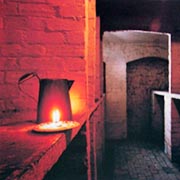Basket and rope making
Baskets
Although they are easily overlooked, baskets were widely used on Regency building sites as they were strong, cheap and quick to fabricate and could be made to virtually any shape. They were also easy to transport between manufacturer and user and were extremely strong. This strength was exploited in two different ways. Baskets were able to take the impact of minor knocks or bumps during the transportation process, making them ideal containers for fragile goods, such as pre-fabricated plaster mouldings. They were also lightweight and yet able to lift very heavy loads which made them ideal as containers with which to haul materials up and down scaffold.
 Occasionally, baskets were made from products such as cane or rush but traditionally they were made of willow which was grown specially for the purpose. The centre of willow growing in Britain has long been the Somerset Levels, which offer the appropriate combination of wet and dry seasonal variation. In Sussex willow was grown in small quantities in the Weald and was used for basket making. At present it is unclear as to whether the large scale demand for baskets created by Brighton’s rapid development was met from local sources or baskets supplied from Somerset.
Occasionally, baskets were made from products such as cane or rush but traditionally they were made of willow which was grown specially for the purpose. The centre of willow growing in Britain has long been the Somerset Levels, which offer the appropriate combination of wet and dry seasonal variation. In Sussex willow was grown in small quantities in the Weald and was used for basket making. At present it is unclear as to whether the large scale demand for baskets created by Brighton’s rapid development was met from local sources or baskets supplied from Somerset.
Different varieties of willow were grown for specialist purposes and the individual wood types could be treated to produce different finishes. For example, it could be boiled and stripped to make a buff basket, stripped to produce a white product, steamed in its bark to produce dark colours, or simply left naturally green.
Basket makers traditionally worked sitting on a short plank close to the ground for easy access to tools and materials. A basket maker uses many tools to cut and split the willow rods and to help weave and push them into place. They used a set of hand tools which included splitters and shavers for preparing the willow, a measure stick to ensure the material used was of the right size, a commanda (a metal length) with which to wrap down and straighten the willow, a bodkin for piercing the wood, a narrow triangular ‘beating iron’ was then used to push the weave close together, shears and a knife for trimming and cutting points and a weight to hold the basket in position whilst it was finished.

When a basket is made, it is usual for the base to be the starting point. Once this has been completed, the rods are bent upwards to form the sides of the basket, before willow is then woven around using different varieties of weave, known as ‘strokes’, to make the different patterns and shapes of particular baskets. Amongst these stokes are ‘Randing’, ‘Upsett’, and ‘Waling’. A willow hoop is passed around the upright frame of the basket at this time to keep everything in place. Finally, the willow ends protruding at the top of the basket are woven into place to form a rim and provide a firm edge.
Of all the crafts associated with the Regency building site, basketmaking has changed the least because it has not proved possible to fully mechanise the production process.
Ropes
Natural fibre rope was an essential product on the Regency building site as it was used for haulage purposes, lifting building materials and tying scaffold together. Made from fibres of jute and flax, much rope was probably imported from Bridport, the Georgian rope making centre of England. Bridport is planned around ‘The Rope Walks’, narrow passages in which the slim ropes were manufactured, bonded and bound into standard lengths for sale. It is also probable that some rope was sourced from local suppliers to the shipbuilding and fishing industries on the south coast.
If you are interested in further reading on this topic, these links will provide you with more information:
The Telegraph; Rope making, stranded ghosts of a bygone age
Rope making at the Morwellham Quay history
Chatham's Master Ropemakers' rope making process
Chatham's Master Ropemakers' history
'Modern History of Wire Rope' by Donald Sayenga
Discover Dorset; The Bridport rope industry
Family forest's history of British basket making
The Somerset Willow Company Ltd. basket making history
The worshipful Company of Basketmakers; history of basket works
BBC: From cradle to grave: Willows and basketmaking in Somerset



